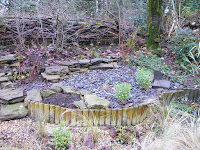Extending the seasonal interest in the garden is a challenge for all keen gardeners but perhaps a little more so for those of us in more marginal growing regions. Our Pennine garden still has a nice selection of colourful corners and plants which offer curious little glories. The soft light of the autumnal day or the golden glow of the sunset can enhance the appearance of most gardens. However, I confess to enjoying the still days when fine mists cloak the hills and give an aura of calm and tranquility, heightening the sounds of the wildlife and the smell of distant bonfires lingering in the air.
The views across the valley from the upper levels of the garden are transformed by the gentle mists. It is therefore important to have good reason to go up the garden and make time to enjoy them. While there are still plenty of autumn gardening jobs to be getting along with, there is always time for some relaxing contemplations, preferably with the
company of a furball or two.
There are, I have found, a few quite simple tips for extending the seasonal interest:
Top Tip: know your plants, for instance the grasses on the upper levels have lost the colourful flecks provided by the daisies and poppies, but many of the stems hold their form and their subdued "oaty" hues are subtly attractive. Even without flashy red berries or orange and vivid yellow foliage that provide most of the autumnal colour in the landscape, I think the grasses are one of our seasonal highlights.
The grasses may not be at their resplendent best but still hold plenty of interest and a nice focal point. As you can see the cherry trees along the top boundary are still in the process of shedding their leaves, thus giving a slightly unkempt appearance but the need to rake them out of the grass beds has multiple benefits
~ it helps to tidy the bed
~ the leaves can be collected for making leaf mould
~ collection involves combing the grasses with the tined rake, which itself is good for the grasses, teasing out dead and dying matter and reducing the risk of the grass clumps rotting during the inevitable damp spells ahead.
The black grasses at the front
ophiopogon planiscapus 'Nigrescens' help define the beds and being evergreen (or everblack!) this is even the case through the darkest winter months.
Top Tip: incorporate some plants that have seasonal interest because of their unusual or colourful bark. The dogwood at the top of the grasses does exactly this job.
Top Tip: some plants will still flower late into the season, so position these wisely to ensure maximum benefit. A good example from our garden is the "Brother Cadfael rose" which lives quite happily in a pot on the patio. It is a lovely bushy shrub rose with a repeat flowering habit, early and very late season. Being located outside the kitchen window means that maximum benefit is gained from this lovely plant.
Top Tip: plant for foliage. The monochrome effect of the terrace is rapidly becoming a personal favourite of mine at this time of the year. The leaves of the hebe and flax contrast so well with those of the still almost white chickweed. Hecate does her best to enhance the effect with her black and white colouring


















































